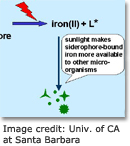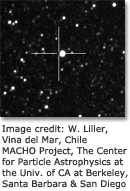 |

|
 |
 Nobel
Prizes in Science and NSF Connection Nobel
Prizes in Science and NSF Connection
"I am so pleased to congratulate this year’s Nobel laureates
in science for their much-deserved recognition. Their accomplishments
also reflect the foresight of the American people who, through the
National Science Foundation, supported decades of their ground-breaking
work," NSF Director Rita R. Colwell said in an Oct. 10 press statement.
"Of the 12 Nobelists announced this week, eight were supported by
NSF at some time in their careers and five currently receive NSF
funding."
More... (posted
October 11, 2001)
|
 |
|
 Scientists
Chart Iron Cycle in Ocean Scientists
Chart Iron Cycle in Ocean
Scientists at the University of California have found that sunlight
plays an important role in cycling iron in the ocean and making
it available to marine life. Iron, which is necessary for the sustenance
of life, is scarce in the ocean. National Science Foundation (NSF)-supported
researchers found that light helps transform the mineral into a
form that can be easily taken up by phytoplankton and other microorganisms.
They report their findings in the September 27 issue of the journal
Nature.
More... (posted
October 1, 2001)
|
 |
|
 NSF
Announces $156 Million in Awards for Information Technology Research NSF
Announces $156 Million in Awards for Information Technology Research
The National Science Foundation (NSF) recently announced 309 awards
designed to preserve America’s position as the world leader
of computer science and its applications. The projects will receive
more than $156 million from NSF’s Information Technology Research
(ITR) priority area, which spurs fundamental research and innovative
uses of IT in science and engineering. "NSF is proud to be
a leader with these bold ITR projects," said NSF Director Rita
Colwell in a presentation to the President’s Information Technology
Advisory Committee meeting, where she announced the awards. "Through
long-term, high-risk research, we expect a wide range of positive
results that will benefit the nation as a whole."
More... (posted
October 1, 2001)
|
 |
|
 Search
of Galactic Halo Yields a Treasure Trove of Variable Stars Search
of Galactic Halo Yields a Treasure Trove of Variable Stars
A project supported by the National Science Foundation (NSF) to
determine the nature of dark matter in the halo of the Milky Way
has yielded a treasure trove of data on 73 million stars.
Many of them are variable stars, whose brightness varies over time
and which are particularly useful for astronomical research. The
database, created by an international team in Australia and the
United States, has been made available to astronomers worldwide
via the World Wide Web.
More...
(posted October 1, 2001)
|
 |
|
 Big
Plans on a Small Scale: NSF Funds Centers for Nanoscale Research Big
Plans on a Small Scale: NSF Funds Centers for Nanoscale Research
Research at the nanoscale is needed to advance the development of
the ultra-small technology that will transform electronics, materials,
medicine and many other fields. The National Science Foundation
(NSF) today announced on Sept. 19 awards estimated to total $65
million over five years to fund six major centers in nanoscale science
and engineering. The awards are part of a series of NSF grants --
totaling $150 million in fiscal year 2001 alone -- for research
in multiple disciplines. The six centers will be located at Columbia
and Cornell Universities and Rensselaer Polytechnic Institute in
New York, Harvard University in Massachusetts, Northwestern University
in Illinois, and Rice University in Texas.
More...
(posted October 1, 2001)
|


|

